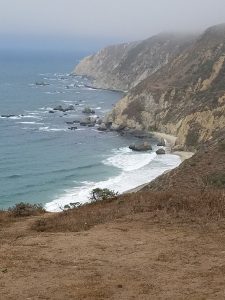Winter 2018 RANGE magazine

It is dusk at Point Reyes National Seashore, the end of a fog-swept, chilly afternoon. Most of the tourists have left for the day out on the lighthouse road, which winds through grassy hills and finger-like sand dunes past the alphabet ranches: A, B, C, D. Dairy cattle lounge on hillsides; some are lining up at pasture gates waiting to be milked. As the light fades, the bachelor elk appear, bugling away and moving from their sketchily appropriated home on the D Ranch toward the C Ranch fence. Half a dozen tourist vehicles park in the middle of the road to admire them and take pictures on their phones in the fading light. The bulls gaze longingly at the Historic C Ranch organic pasture, only a dozen yards away across a poorly maintained two-lane strip of asphalt and a three-wire fence. Neither will pose a problem.
Within a few hours, somewhere between 60 and 100 head will trot across the road, jump this fence, and make themselves at home on the newly rejuvenated grasses of the Spaletta family’s organic dairy. They will eat whatever $390-a-ton organic hay they can steal, although the Spalettas have ceased feeding hay on the ground to their milk cows and now confine the hay to racks too narrow for the antlered bulls, at least, to stick their heads into. It saves money, but it’s not the best thing for the milk cows, which would be better served to scatter across their pasture for their post-milking meal.
One hundred adult elk can consume a ton of forage and drink 1,600 gallons of water a day. These elk will stay and feed all night, wandering off in the morning to ruminate back on the D Ranch, which according to wildlife biologist Dave Press “isn’t in cattle grazing at the moment.” What he doesn’t say, in his deflective way, is that the Seashore cancelled the D Ranch’s long-standing lease when the family’s matriarch was killed in a car accident, effectively throwing her kids off the place not long after the funeral.
Soon after that, radio-collared elk mysteriously appeared on the D Ranch from the Limantour Wilderness, on the other side of Drake’s Estero. Press explains that after they released 28 radio-collared elk into the wilderness area, “On day two there were two females missing. We knew they were alive, we just couldn’t locate them. Three weeks later they turned up at Drake’s Beach [bordering the D Ranch]. We don’t know whether they went around or whether they swam the Estero, but there they were. Then the rut rolls around, and suddenly they were back over at Limantour. They came back a few months later, and one of them calved there at Drake’s Beach. They did this little back and forth for a few years and then in 2001 they came back over to Drake’s with a male and another female, and they have grown from there. We have been watching that herd very, very closely since then and they show no signs of moving back over to Limantour.” And why would they? All that swimming, when there’s organic hay right across the road.
Ranchers who saw scarred and muddy elk wandering lost on the D Ranch the morning after unmarked trucks and trailers showed up after dark are more than skeptical of this fairy tale. But it doesn’t matter now. The elk are there, and despite the Point Reyes Seashore’s own elk management plan, which says that the park will remove those animals which escape from the wilderness area onto ranchers’ pastures, the park staff are confining their management to “watching that herd, very, very closely.”
Occasionally a ranger will show up on the Spaletta farm and drive around wildly, chasing the elk back through the remains of the three-wire fence and across the road in a ludicrous burst of activity, where they will stay till the ranger goes back to park headquarters. Press says the park staff has been doing a fair amount of that. “We call it ‘hazing’…when we see that there’s a herd of 60 to 80 elk that are consistently occupying one of those key pastures, day in and day out, day in and day out, we go in there and just kind of ‘walk them out.’” He makes a “shooing” movement with his hands. “We just walk them off the pastures.”
Read on: